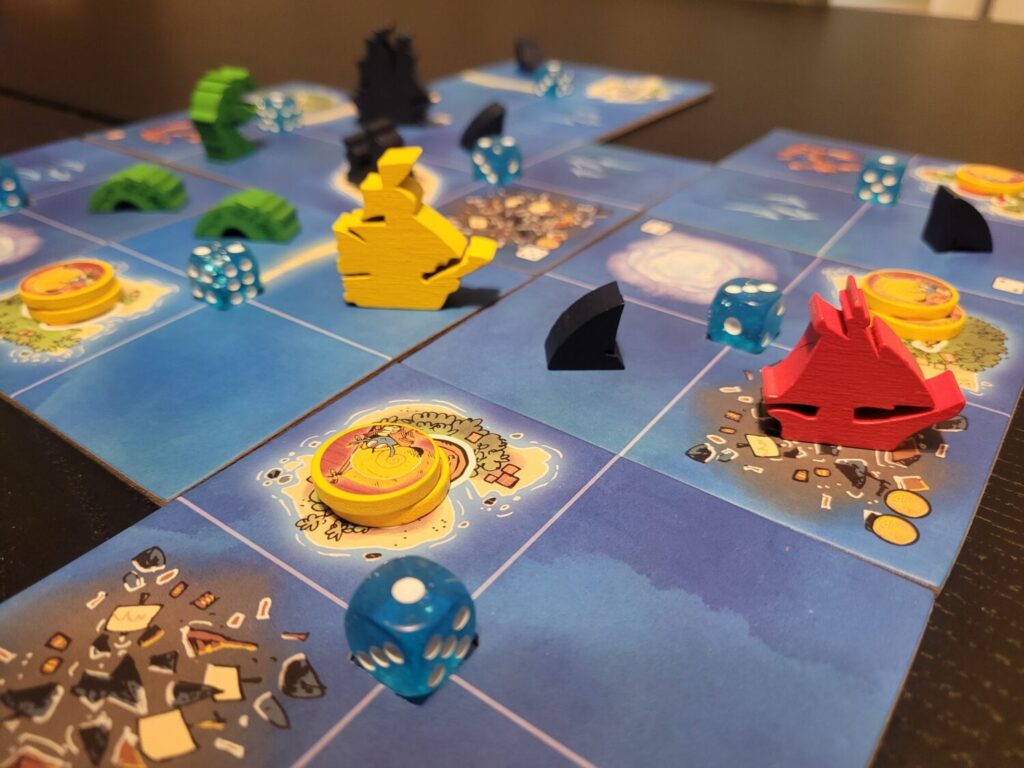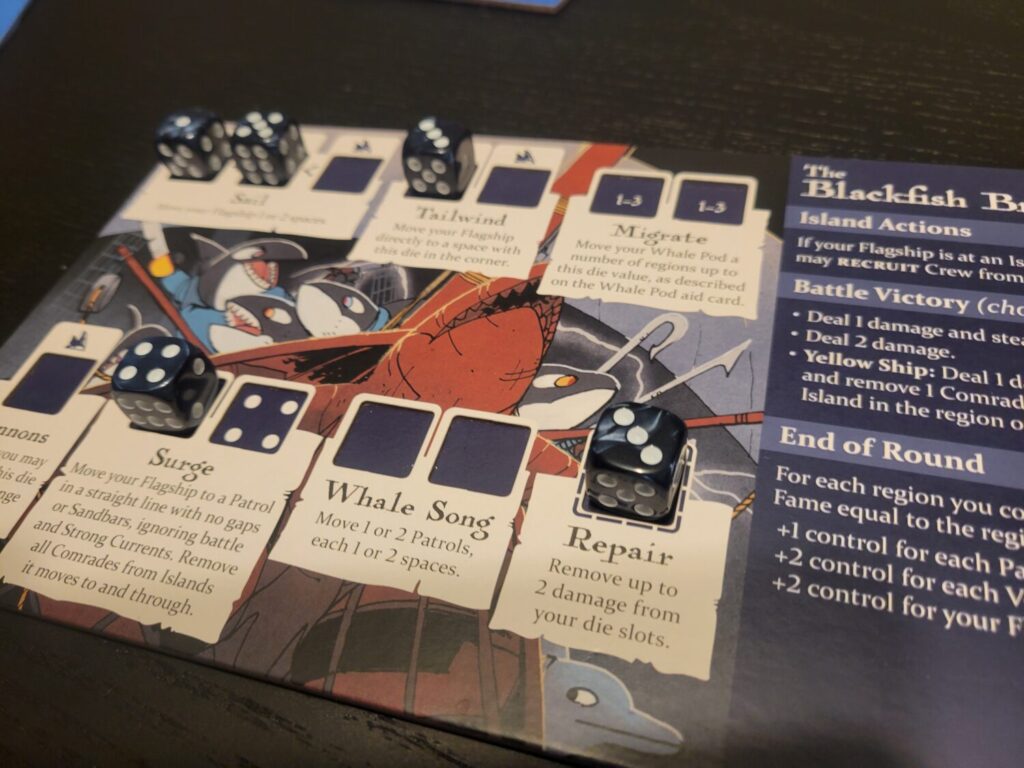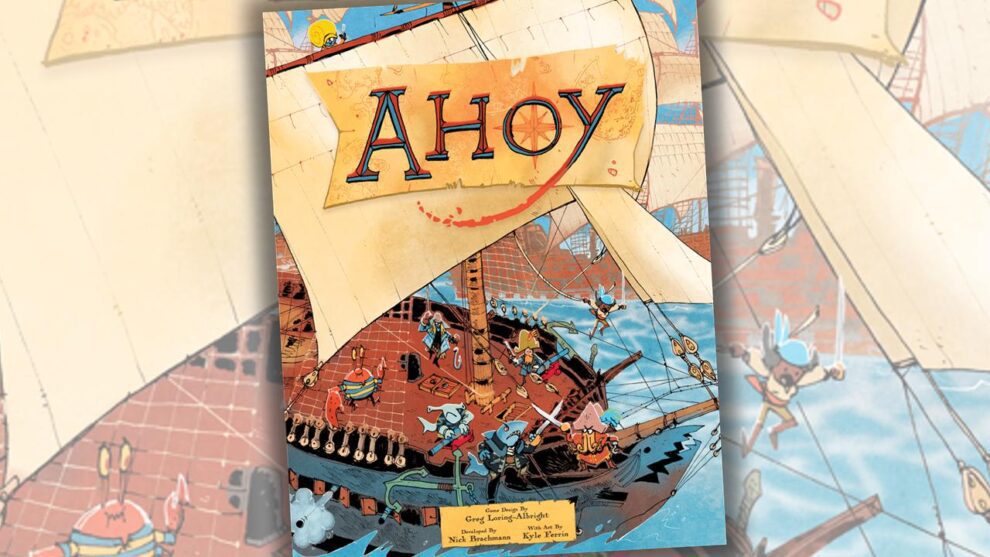In the Leder Games Extended Universe, you’ve got all the flavors of asymmetry. There’s my favorite, Oath, 1 vs. many shared tableau zany asymmetry; there’s Vast, which is quasi-dungeon-crawler asymmetry; there’s Arcs, asymmetry that builds over 9 hours (if you’re going campaign-style); there’s Root, which is DO YOUR JOB asymmetry smashed into an area control framework; finally, you have Ahoy, which is logistics asymmetry.
With this vast menu of options available, I’m not sure asymmetry as envisioned by Leder Games is good.
Avast, uh, lubbers?
In Ahoy, players take on different roles depending on player count, but you’ll always have two beat-em-up logistics factions. With three, you’ll add one goofy logistics faction, and with four you’ll have two.
The four (with both expansions) beat-em-up factions come in two varieties: you’ve got two factions that dump out little mini ships that are annoying and control territory, and you have two factions that manipulate a currency-like supply of yellow discs across islands on the board. The discs can’t fight, but they control territory and are barnacles that must be scrubbed from the map or this faction will overwhelm everyone.

Both of these factions (Bluefin Squadron/Blackfish Brigade) and (Mollusk Union/Shellfire Rebellion) are attempting to control regions, which are tiles on the board made up of four spaces apiece. At the end of each of the game’s rounds, each region scores an amount of points equal to a little die in the center of the region, which starts at 1. The area control factions are squabbling over each region, trying to have more influence points.
The goofy factions, which in the base game are only smugglers, play a basic pick-up-and-deliver game with a single ship. They go around to various islands on the map, picking up cards from a market that match the suit of the island they’re picking up from, and travel to a different destination and deliver. They get points for doing so and also cause the regions’ scoring value to increase with each delivery.
The other goofy factions are a leviathan that eats cards and Mollusk/Shellfire discs to power itself up, and tries to form a long adjacent snakeform with its various body and head pieces. There’s also the Coral Cap Pirates that form a large fleet out of highly specialized ships and get secret points at the end. All of the factions are designed well, and do what they’re supposed to do, though the Coral Cap Pirates are often a bit too baroque for my tastes.
How is all of this managed?
DICE
Dice! You roll them, and on your turn, you allocate two to various slots in your board that allow you to interact with various bits of the game. Combat also uses dice and is pretty simple. You can allocate cannons, which causes fights to occur whenever anyone with cannons crosses paths. The cannon dice are reduced, the totals are added to their respective player roll, and the higher roll wins.
You run around, blast each other, and try to wrap your head around what everyone is trying to do and poke people in the eyes when appropriate. And, given the way games like this are designed, all the time is appropriate, even by accident.
Tactical logistics
I mentioned before that this is the logistics asymmetry game. I got the feeling from folks online that Ahoy is sold as a lighter offering compared to the rest of the Leder Games catalog. This is untrue. There’s quite a bit going on, even without expansions, and ultimately, the game is about hamstringing the winner on your turn while moving yourself forward.
In order to do said hamstringing, it’s necessary to understand how each faction that is playing the game can affect the game state. You need to know, for example, that the faction that throws pieces across the board can do so in a variable amount driven by a die face, and you need to position yourself so you can interfere with that throwing, while also setting yourself up properly to get the most amount of points come score time.
The damning-with-faint-praise-thing about Ahoy to me is that the design work is…fine? There’s nothing about it that demands revision or fixing. You socket dice into slots and do different actions, and you have a set of private objectives that you want to accomplish because, well, only you can accomplish them. I’m happy I got to spend time with it, because Ahoy brought into focus a critique about a more recent trend in game design, though it isn’t a totally new one—factions and asymmetry.
I’m sick of asymmetry
Now, I’m not talking about players having different powers or capabilities—that’s a very common feature that many many many games share. I’m talking about games like Root, Arcs, Sidereal Confluence, Circadians: Chaos Order, the COIN series, and, to some extent, explosive tableau builders like the Pax series.
These games have an odd anti-social ethos, at least from my perspective. In these games, you start with (or create) your own private game win state and rules. You then must force a collective game state to match your state so you can win.

And while you might say that these games have players competing over a shared metric—points—I’m curious. Are you actually competing over that? In Ahoy, two factions will be pushing and pulling at each other over control, a shared site of competition, but the other two will be running around picking up and delivering things. On top of this, players will develop a slew of asymmetry that further distances them from each other. It’s like you and your childhood best friend are wrestling over a ball on a trampoline, and you have to make sure that your little brother doesn’t accidentally make napalm in the kiddie pool off to the side. Sure, all of this converts to points somehow, but good luck parsing it all.
There’s something anti-social about this to me. Instead of the agreement that we often make when we play games—this is a competition to see who can do the best within the parameters of the game—games with this level of asymmetry instead ask you to do the best given a narrow set of circumstances that apply only to you. Oh, and yes, you need to flail at someone else wildly with a stick occasionally to try and knock them off their own little balance beam. Sidereal Confluence tries to sidestep this by making players initially dependent on others for success, but as the game progresses, you float away into your own private universe as well.
I commonly think about interaction in games as either positive or negative. Negative interaction features you taking things from other players to secure a win, while positive interaction has you utilizing the networks and creations of other players to try and outcompete them (think Risk vs. Brass/Concordia or something like that). Games that feature this sort of asymmetry have some other form. You take things from other players that you don’t really want so they don’t win. It allows game designers to be creative while limiting the creativity of their players. Games that I love, like Imperial, Terra Mystica, Rise & Fall, Argent: The Consortium, De Vulgari Eloquentia, Leder’s Oath—they all ask players to compete over a shared play space where players start with and develop wildly different powers and positions. Oath has asymmetry and surprise victory conditions, and they can sometimes feel disconnected, but it doesn’t feel as island-like as games like Ahoy do.
I realize that this was a great many comparisons at once, but reading about Ahoy, I see many people saying not much about it, and I’m not sure that this is due to the design itself, but rather its ethos. I do not have much interest in playing within someone else’s idea of how they think I should play their game, I would like to discover that for myself.










